All your questions about kids & face masks, answered

We asked doctors and epidemiologists the biggest questions parents have about wearing masks at school–including which face masks are most effective, and how to get kids to wear them.
Table of Contents
- What kind of face mask is best for children to wear at school?
- Are clear plastic face shields effective and safe for kids to wear?
- What can parents or caregivers do to help kids feel comfortable wearing a mask?
- Are face masks safe for kids?
- What if my child just really, really hates wearing a mask?
- We've tried and tested TONS of masks over the past year and a half. These are some of the best kids' face masks that they'll actually wear.
School will again be different in many ways this fall, no matter where you live or what your local district’s plans are. But regardless of the uncertainty that still surrounds schedules, social distancing and hybrid learning, one thing, at least, is clear: Wearing a mask is recommended or required.
So which masks are safest and most effective for kids—and how do you convince kids to wear them? We asked doctors and epidemiologists the biggest questions parents have about wearing masks at school.
What kind of face mask is best for children to wear at school?
There’s a surprising number of face mask options out there, but parents want to know which type of face mask is most effective and safe for kids in a school setting—cloth masks? Surgical masks? Face shields? Neck gaiters? Or just any kind of mask they’d actually tolerate wearing?
As it turns out, every expert we asked was in agreement on this point. “A cloth mask is the best option for most children,” says Sara B. Johnson , Ph.D., M.P.H., Associate Professor of Pediatrics and Public Health at the Johns Hopkins University School of Medicine.
Dr. Melissa Hawkins , an epidemiologist, mom of four and Director of the Public Health Scholars Program in the Department of Health Studies at American University, agrees: “For a school setting, I recommend cotton masks with adjustable elastic ear loops because they are highly effective, comfortable and washable.”
In addition to being reusable and washable, cloth face masks with adjustable ear loops are easier to adjust to fit than one-size-fits-all surgical masks. Cloth face masks are also less irritating to the skin than medical-style masks made of more fibrous woven material and are less likely to slip down or lose elasticity than a neck gaiter. Neck gaiters leave the actual act of covering the mouth and nose up to the responsibility of the wearer, which makes them less than ideal for kids.
Dr. Daniel Berliner , a physician for virtual health platform PlushCare, agrees: “While more sophisticated masks [like KN95 masks] do the best job, any face covering that is comfortable and that will be worn is much better than no mask.”
KN95 masks have been tested to filter out 95% of particulate matter, but they’re not necessarily essential for kids to wear, especially if your kiddo tends to balk at heavier-duty masks.
Bottom line: “The most effective mask would be the one the child finds comfortable,” as Dr. Eudene Harry , Medical Director for Oasis Wellness and Rejuvenation Center, puts it. And for most kids, the most comfortable mask is a child-sized cloth face covering with elastic ear loops.
Reminder: Children under the age of 2 should not wear face masks, as recommended by the Centers for Disease Control and Prevention (CDC).
Are clear plastic face shields effective and safe for kids to wear?
Cloth masks are actually preferable to plastic face shields (worn on their own) for the purposes of preventing viral spread. “A face shield protects the wearer but is not as good at keeping infectious droplets in, since the sides and bottom are open,” Johnson says.
According to Dr. Harry, “the CDC doesn’t recommend face shields instead of face masks because they aren’t known to offer similar protection from aerosolized particles.” If, however, your child is unable to wear a face mask and you opt to have them wear a shield, “be sure that it goes around the side of the face and below the chin,” she advises.
Dr. Hawkins neatly breaks down the pros and cons of plastic face shields for kids this way: “Face shields can be more comfortable than masks, especially if your child wears glasses, which easily fog with masks. Shields cover the entire face and make it harder for a child to touch their nose, mouth and eyes, and they are easy to clean and disinfect after each use. The drawbacks: First, they provide good protection to the child wearing it, but less so for other people because the face shield is away from the face and thus respiratory droplets can easily escape and spread. Second, because they are less effective, the CDC currently recommends masks be worn along with a face shield.”
Plastic face shields may be hard to wear for younger children, Johnson notes, although a shield can be worn over a cloth face mask. If children are “developmentally ready” to wear a face shield over a mask, she says, “that’s an option, but for most children, a cloth mask is fine.”
What can parents or caregivers do to help kids feel comfortable wearing a mask?
Experts agree that children are incredibly adaptable—in fact, as Dr. Harry observes, “children sometimes adapt more readily than adults to change.” While wearing a mask may feel uncomfortable or strange at first, the good news is that kids will adjust, especially when they see that all their friends and teachers at school are in the same boat.
In the meantime, here are some ways parents can ease kids into wearing masks at school.
Practice: “We’ve found that children get better at wearing masks with practice, so practice over the summer with your children until they are used to wearing the mask,” Johnson suggests. “That includes how to put it on with clean hands, how to remove it and how to wash or sanitize hands after.”
Meet them where they are: “Children are children, so demonstrating on their favorite stuffed animals or allowing them to decorate their own mask can help to introduce it in a way that they can understand,” suggests Dr. Harry.
Let them choose: “You can involve your child in picking out the mask, or consider personalizing it with permanent markers. Kids are more likely to wear a mask if they like the design,” Johnson says.
Make sure your child’s mask actually fits them comfortably: “Because we don’t want children to touch their faces to adjust the mask, it’s important to try to find one that’s the right size for your child,” Johnson says. “A too-big mask is likely to slip and require a lot of adjustment.”
Encourage their sense of responsibility for others: “Parents can say, ‘Masks are for superheroes and helpers, and that’s what we are when we wear our masks. When we wear a mask, we help keep the people around us safe and help keep our germs away from other people,'” Johnson suggests.
Put mask-wearing into a healthy context they understand: Most kids know that washing hands, using tissues (instead of sleeves) and sneezing and coughing into our elbows are all everyday actions we should take to help keep germs from spreading—even when we’re not sick. Wearing a mask is in the same category: just one more way to keep ourselves and others healthy.
“Explain to your child that it’s important to wear a mask to help protect other people and keep themselves safe,” Dr. Harry suggests. “You may have discussed with your child the importance of handwashing to keep hands clean before eating, after using the bathroom, and so on. You can just reinforce that this is just another way to do that.”
Make it memorable: Early education experts know that repetition and rhyme are effective in introducing new concepts to young children. Your family can adopt its own rhyme, reminder or affirmation to encourage kids to wear their masks—Dr. Hawkins suggested a few:
- Be a friend, wear a mask.
- Your first task is to wear your mask.
- My mask protects you and your mask protects me. Masks help us keep each other healthy.
- Heroes wear masks.
- Caring is sharing, but not germs. Wear a mask.
Model mask-wearing yourself, and point out masks in your community: “Wear your mask whenever you’re within 6 feet of people who don’t live in your household,” Johnson says. “Point out to your child people who are wearing masks and reinforce the idea that everyone is helping.”
Teach them how to wear a mask properly: Show them that they should always wash hands before and after putting on their mask, and help them make sure their nose, mouth and chin are fully covered. “Remind them to always avoid touching the mask when it’s on their face and to take it off from behind their ears and not from the face part,” Hawkins notes.
Wash masks frequently—both for health + comfort: No one wants to wear a smelly, stained mask, no matter how important it is.
Are face masks safe for kids?
Unfortunately, there are a lot of misconceptions out there about mask-wearing, and even well-meaning people can be misled by confusing or contradictory claims. So if you’re hearing from relatives or friends or neighbors that face masks are unsafe or unnecessary for children, be empathetic, while arming yourself with the facts.
Here’s what experts want parents to know about the safety and efficacy of masks for children.
Masks are safe—they do not “smother” kids, inhibit their intake of oxygen, or cause excess intake of carbon dioxide. “Masks do not effectively serve as a barrier to transmission of gases like they do in stopping particulate matter,” Dr. Berliner points out. “So while masks will greatly reduce movement of virus particles, oxygen and carbon dioxide gases will flow freely. In other words, kids wearing masks at school will be able to adequately breathe air in and out and not have significant changes in their normal, unmasked levels of oxygen and carbon dioxide.”
Johnson agrees: “There are a lot of misconceptions about wearing a cloth face covering. There’s generally no reason to worry about reduced airflow, or increased CO2 intake, or increased risk for infection related to a cloth face mask; they allow plenty of air exchange.”
And one more time for those in the back (or for those with friends or relatives that really need convincing): “Wearing a face mask has not been shown to increase CO2 levels or decrease oxygen levels in individuals with normal lung function. Keep in mind that hospital personnel wear masks for many hours a day and are okay,” Dr. Harry points out. “If a person has a lung disease and wears the more tightly woven KN95 mask, then there is a possibility of CO2 increasing. These individuals should speak with their physicians. Cloth masks allow for easy exchange of oxygen and CO2.”
Masks are effective. “Mask wearing is especially important to reduce asymptomatic spread, a larger driver of the infection rates across the country,” notes Dr. Hawkins. “We know that universal mask-wearing will significantly reduce viral transmission rates in communities and nationally.”
Masks—and vaccinations—are among the most affordable, easy-to-use weapons we have against the spread of coronavirus. “Physical distancing, frequent hand-washing and consistency in mask wearing are tried and true (no cost) prevention approaches that do work,” says Dr. Hawkins.
Masks will be especially important for preventing viral spread in schools. “Some parents may believe that children do not contribute to the transmission of the coronavirus,” Dr. Hawkins says, but “when schools open again in the fall, children will be together in groups and the usual respiratory illnesses will circulate as they always do. When children are coughing and sneezing more regularly due to other illnesses (or due to COVID-19), it is likely the virus will be spread easily and readily. This is certainly the case for all other respiratory viruses, including other strains of coronavirus. So, two good reasons to wear a mask—reduce the risk of coronavirus and the risk of the other pesky respiratory illnesses that are commonplace in school settings.”
Masks are a sign of care for our communities. “Wearing masks is something new to many kids and parents,” Johnson acknowledges. “Like any new skill we teach our children, it can be confusing and scary at first; our job is to help children realize how they’re helping. Building empathy and care for others is something that will benefit our kids long after the pandemic.
If these expert assurances from a range of doctors and epidemiologists are not enough to change other people’s thinking, remember this, mama: Your main responsibility is your children’s health and your own well-being—both physical and mental. Control what you can, and let go of the rest.
What if my child just really, really hates wearing a mask?
“Just as with any new health habit, wearing a mask will take practice before your child becomes accustomed to it,” acknowledges epidemiologist Dr. Melissa Hawkins. But with love and patience, there are many ways parents can help even the most resistant kids adjust to the change. A few effective methods Dr. Hawkins suggests:
Use frequent and positive reinforcement. Praise kids for being helpful heroes by wearing masks, and praise others in their class and their community for doing the same.
Help kids understand the why . Talk with children in age-appropriate terms about the importance of mask-wearing and explain germs in simple terms, Dr. Hawkins suggests. For example, explain that germs can go from our body to someone else’s body when we cough, sneeze or breathe too close to someone else. Masks protect our own noses and mouths from germs, but wearing a mask can also protect our friends because it keeps our germs closer to our own bodies.
Explain that masks are the rule right now. Just like wearing shoes to play outside, wearing a seatbelt in the car or wearing a coat when it’s cold, there are certain rules we all follow that help us stay safe and healthy.
Model mask-wearing to show that it’s safe and practice wearing the mask at home. Have your child help you put on your mask. Offer to help your child put on their mask. Suggest your child put the mask on a stuffed animal or doll. Show them pictures of other children wearing masks. Show them pictures of superheroes wearing masks. Just like superheroes, they are helping us all stay healthy.
Validate their feelings + emotions about mask-wearing and comfort them. Share when it’s been frustrating or hot to wear the mask. Invite them to draw how they feel about it.
Offer some simple choices to help them feel more in control. For example, tell them they decide whether to put the mask on when you leave the house or in the car.
Make mask-wearing playful. Let them choose their own mask color and pattern. Let them get creative by decorating their masks with stickers, ribbons and so on.
Be consistent in mask-wearing to establish good habits and routines.
If your child is extra resistant to wearing a mask, experts note that there are a number of perfectly understandable reasons why this might be the case. For example, make sure your child’s mask fits and is comfortable, especially around the ears. Your child might benefit from “fresh air breaks” where they can remove their mask for a short period away from other children—you might consider discussing this possibility with your child’s teacher.
Finally, don’t underestimate the hugely important role you and your family play in helping your child adjust to wearing a face mask. As Dr. Berliner points out, making this change “requires guidance from authority figures, especially parents, that masks are safe, good for your health and really important and necessary. And the best way to impart this message to children is to lead by example.”
While it may feel natural to make jokes about masks or roll our eyes good-naturedly while putting them on, these actions can be interpreted by young children in a different way than we intend, and we can inadvertently become what Dr. Berliner calls a “negative beacon” with regard to wearing masks. If we send the signal to our kids that masks are a pain and an annoyance but oh well, we gotta wear ’em anyway , then, of course, our kids will notice we’re less than enthusiastic.
Each of us can play an important role in reducing the spread of the coronavirus in our communities. Helping our kids adjust to wearing face masks in public and in school is one simple step in saving countless lives.
We’ve tried and tested TONS of masks over the past year and a half. These are some of the best kids’ face masks that they’ll actually wear.
Happy Mask Pro Kids Size
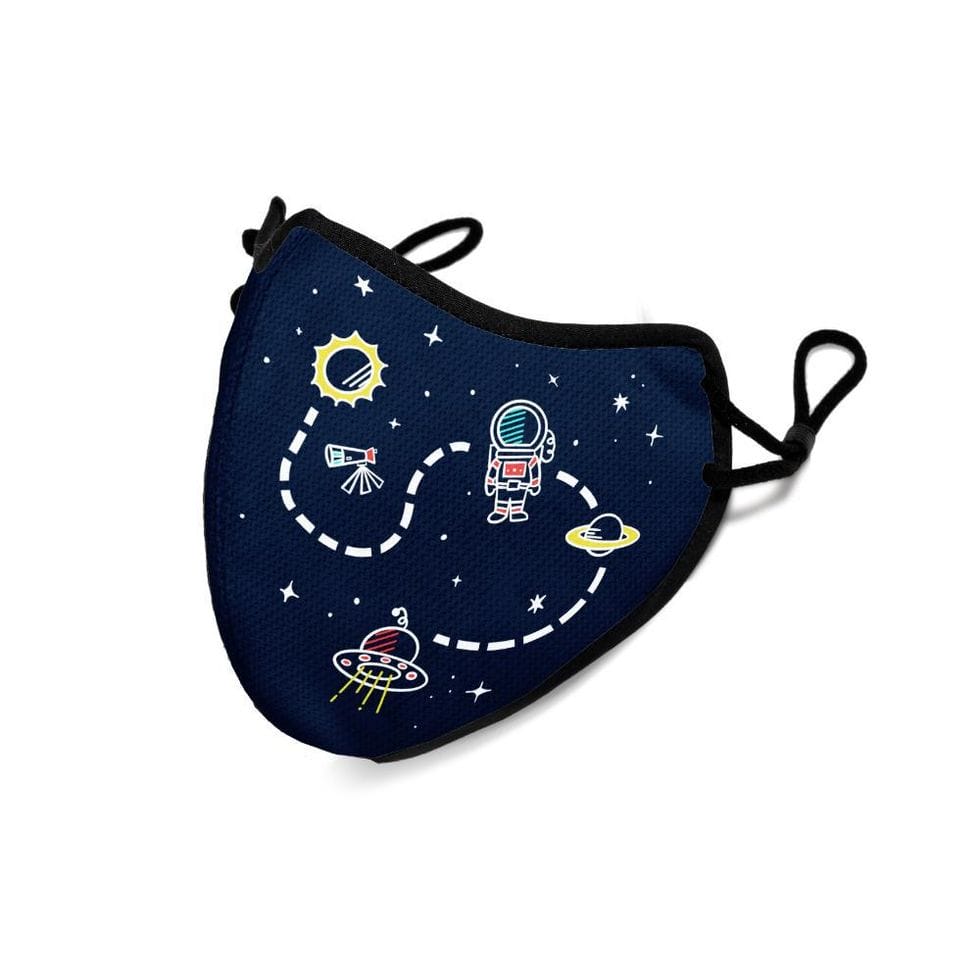
The trademark “parrot beak” shape of Happy Masks kid masks leaves extra space in front of their nose and mouth so it’s easier to speak clearly and not feel stuffy. They’re a hit with the preschool crowd given the fun array of prints and feature an adjustable nose wire to help it stay in place on little faces. They’re currently in and out of stock due to overwhelming demand, but restock regularly.
HMNKIND Mask APM
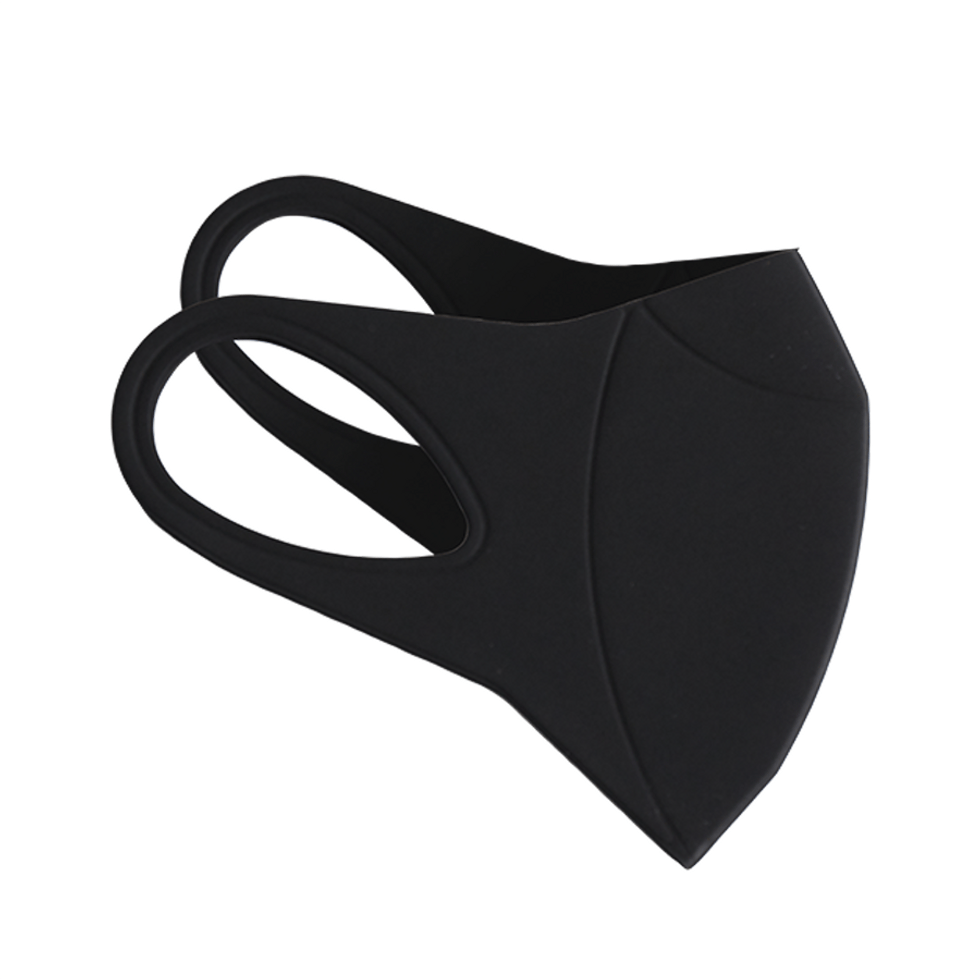
The uniquely constructed HMNKIND masks have been a consistent winner with my elementary schooler. They’re made from a super soft antibacterial material that’s actually used in the Korean beauty industry which makes them non-irritating and more breathable than cotton masks. Size XS is perfect for kiddos!
Crayola Mask Pack

Designed with kids (and their overworked parents) in mind, Crayola’s Mask Packs have the week of accessories covered. Each pack includes five adjustable masks that feature a nose clip, soft inner lining and a mesh bag for washing when the week is over. They’ve been a lifesaver when it comes to helping us avoid reusing and the built-in system of dropping it in the laundry bag at the end of the day has kept us from losing a single one! (And I’m not the only one who loves them. They’ve already wracked up over 14K Amazon ratings !)
Vida FDA Registered KN95 Masks
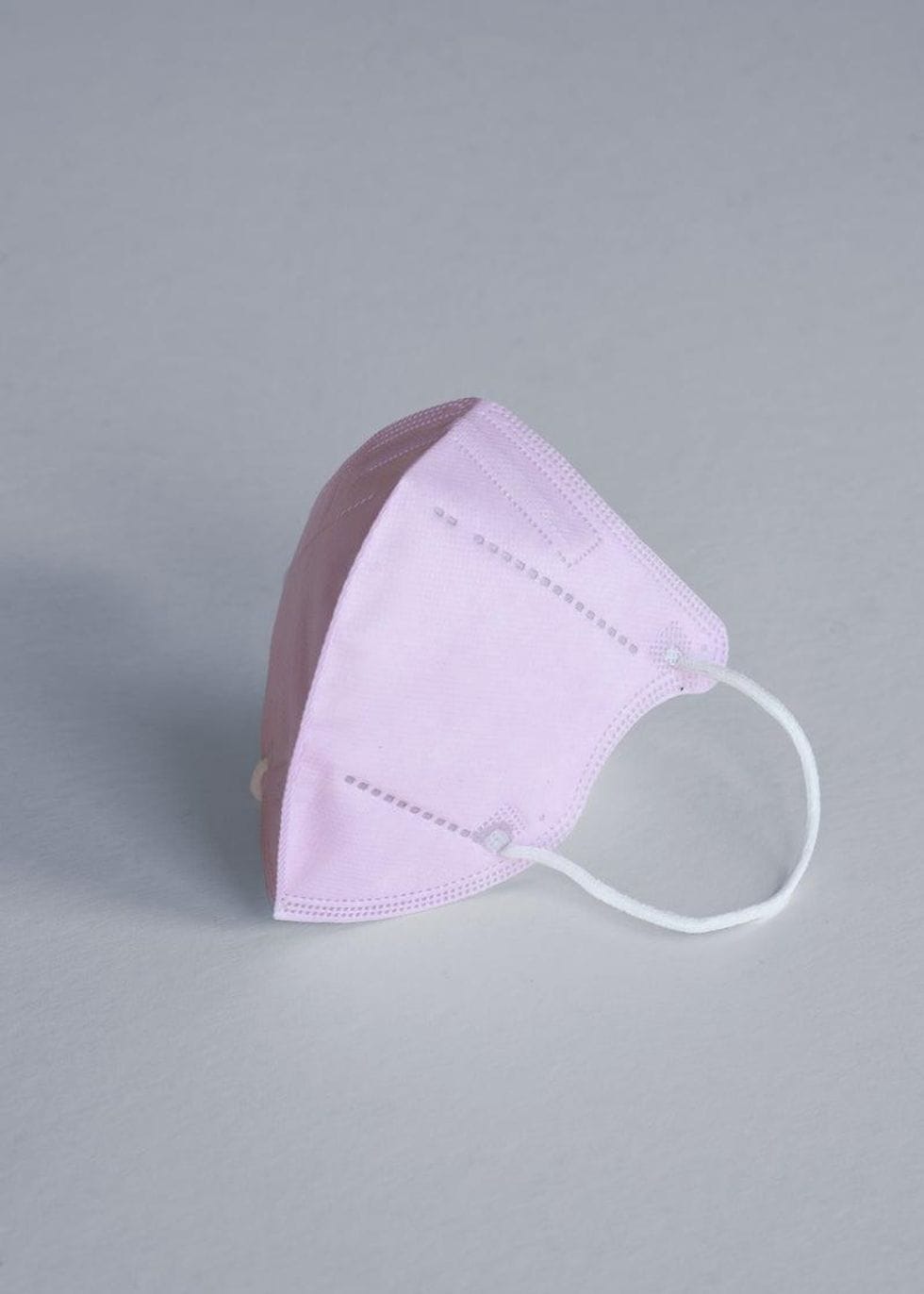
With impressive efficiency (95%+!) and a 5-layer filtration system which includes two premium quality melt-blown layers, VIDA’s kids’ KN95 masks offer comfort and peace of mind. The soft ear bands and a metal nose-piece ensure a snug fit and they come in a bunch of fun colors. We also love that they send along an envelope to send back used masks for recycling!
(Price is for a 10-pack)
Kids Disposable Masks
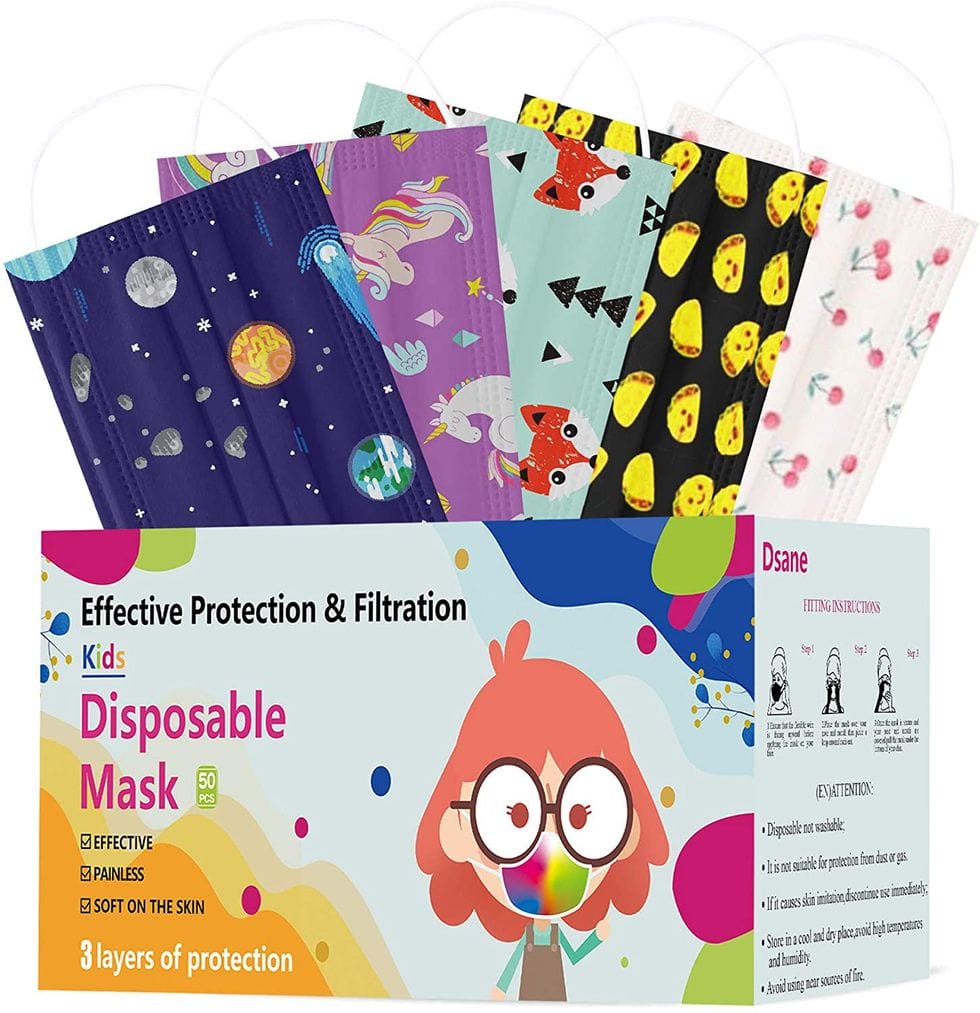
If your little one can’t help putting their mask in their mouth or fabric versions are just too uncomfortable, you may want to stock up on some paper options. Just stick a few in a ziplock so they can swap it if it gets wet or dirty. We love these fun prints which make picking out the day’s look just a little more exciting.
(Price is for a 50-pack)
Piece Products Chewy Mask
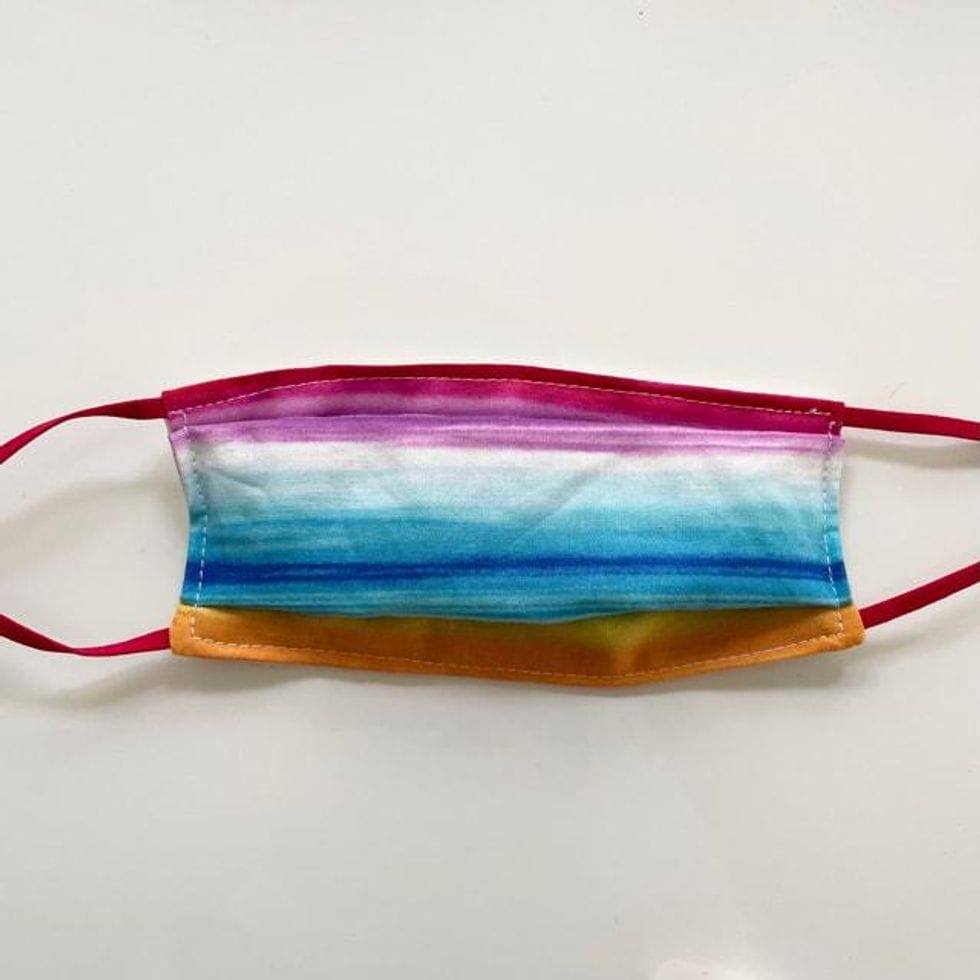
Speaking of putting their mask in their mouth, if your little one is soothed by oral stimulation and struggling with mask wearing, these OT-recommended masks come equipped with a sewn-in food-grade plastic tube on an elastic band which they can bite and chew without having to remove the mask.
Caraa Universal Kids Masks
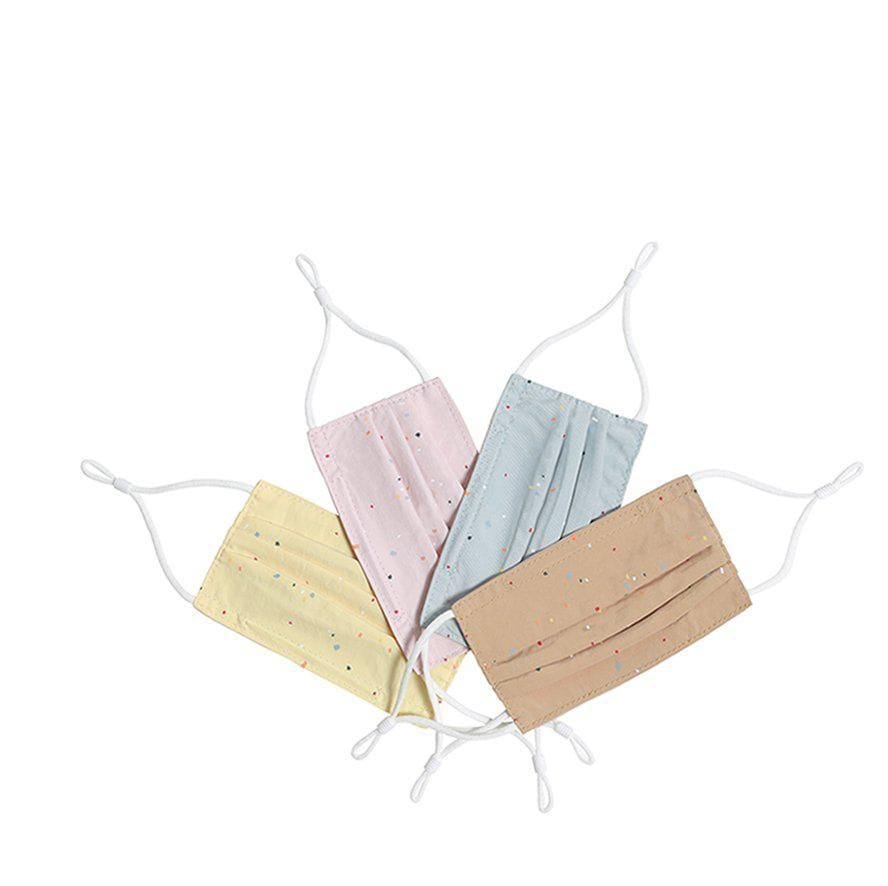
The washable and lightweight masks from Caraa are perfectly sized for preschoolers through elementary school. Made from a soft cotton poplin (just like your favorite dress shirt) they’re comfy and just structured enough to stay out of the way when talking. Adjustable ear loops stay comfortable throughout the day and the nose wire helps to keep it where it belongs.
(Price is for a 4-pack)
[A version of this article was originally published in July 2020. It has been updated.]
We independently select and share the products we love—and may receive a commission if you choose to buy.





































